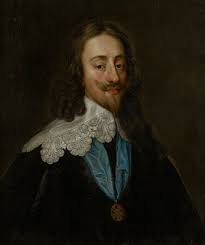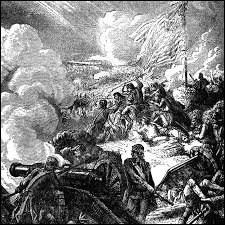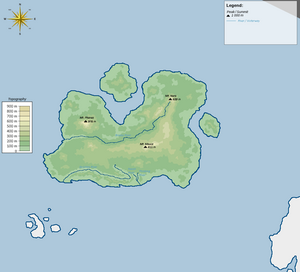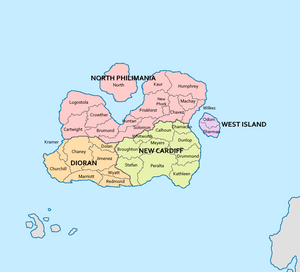Philimania: Difference between revisions
Philimania (talk | contribs) No edit summary |
Philimania (talk | contribs) m (→Early history) |
||
| Line 110: | Line 110: | ||
=== Early history === | === Early history === | ||
Philimania was originally settled between the 3rd and 2nd millennia BCE, most likely from | Philimania was originally settled between the 3rd and 2nd millennia BCE, most likely from {{wp|New Zealand}} and {{wp|Polynesian}}. Philimania was first discovered by British and Spanish pilgrims around May of 1603. | ||
=== British and Spanish pilgrims === | === British and Spanish pilgrims === | ||
Revision as of 06:54, 22 August 2021
This article is incomplete because it is pending further input from participants, or it is a work-in-progress by one author. Please comment on this article's talk page to share your input, comments and questions. Note: To contribute to this article, you may need to seek help from the author(s) of this page. |
Republic of Philimania | |
|---|---|
| Motto: Vita Frui ("Enjoy Life") | |
| Anthem: "Toku Nuu" (English: "My Nation") | |
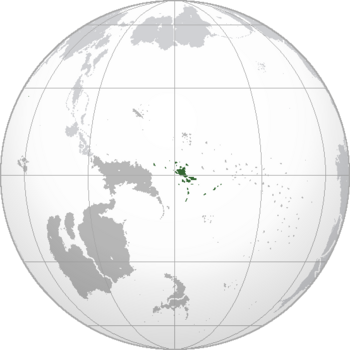 Location of Philimania (dark green) – in South America (grey) | |
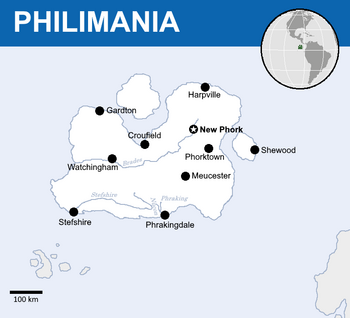 | |
| Capital | New Phork City |
| Largest city | New Phork City |
| Official languages | English |
| Recognised regional languages | Spanish |
| Ethnic groups (2021) | 60% Philimanian 34% Hispanic 6% other |
| Religion |
|
| Demonym(s) | Philimanian |
| Government | Constitutional Federal Republic |
| Nel Karlson | |
| Henry Field | |
| Legislature | |
| Legislative Council | |
| House of Representatives | |
| History | |
• Founding of New Cardiff | May 1603 |
• Founding of Philimania | 19 July 1621 |
| Area | |
• Total | 22,431 km2 (8,661 sq mi) |
| Population | |
• 2019 estimate | |
• 2021 census | 5,543,613 |
• Density | 275/km2 (712.2/sq mi) |
| GDP (PPP) | 2020 estimate |
• Total | |
• Per capita | |
| GDP (nominal) | 2020 estimate |
• Total | |
• Per capita | |
| Gini | low |
| HDI | very high (20th) |
| Currency | Philimanian Dollar (P$) (PD) |
| Time zone | (GMT-6) |
| Date format | dd/mm/yyyy (CE) |
| Driving side | left |
| Calling code | +47 |
| ISO 3166 code | PH |
| Internet TLD | .ph |
The Republic of Philimania, commonly called Philimania, is a federal republic governed by The Philimanian Legislative Council (TPLC) in Western South America. Philimania covers over 20 thousand square kilometres and has a population of over 5 million. The nation consists of 4 provinces.
Philimania was first inhabited by native Polynesians before its founding. Philimania was discovered in 1621 by British and Spanish pilgrims whom fled their homelands to escape persecution.
Philimania is a developed country, with a high national GDP of P$1.342 trillion. The per capita GDP of P$30,120 ranks highly in the world. The economy is fueled almost entirely by the private sector, which is quite specialized and led by the Tourism industry, with significant contributions from Book Publishing, Information Technology, and Arms Manufacturing. The average income is 65,825 dollars and evenly distributed, with the richest citizens earning only 2.7 times as much as the poorest. Philimania ranks highly in civil rights, political freedom, and economic freedom. Philimania is a small power, as well as a member of several international organizations, including the United Nations.
Etymology
The national animal of Philimania is the Wee-Wee Fish which is a type of fish that is only found around Philimania. The term 'Wee-Wee' comes from the person that discovered this species who is known as Hilda Wee-Wee.
The term 'Philimania' is believed by historian to have come from the name of the Polynesian tribe that once lived on the island.
History
Early history
Philimania was originally settled between the 3rd and 2nd millennia BCE, most likely from New Zealand and Polynesian. Philimania was first discovered by British and Spanish pilgrims around May of 1603.
British and Spanish pilgrims
in 1603, the British and Spanish pilgrims settled on what is now the south coast of the province of New Cardiff, and established the State of New Cardiff. There, they founded the city of Phrakingdale.
Over time, the pilgrims and the natives mingled together, and formed a new ethnic group known as Philimanians.
By 1615, the entire Philimanian islands has been explored and settled forming many semi-independent states.
Spanish Discovery and the Seven Years War
In 1621, Philimania is discovered by Spanish Explorers. the Philimanians knew that if they were not united, they would be invaded by them, so, in 19 July 1621 Philimania was united under one banner. and a governor, known as Harry Liam was appointed to rule Philimania. In 1654, the governor passed away and The Philimanian Legislative Council was formed.
Eventually Philimania opened trading posts along the coast to trade with the Spanish, and eventually Britain and France in the late 17th Century. During The Seven Years War, Spain declared war on Philimania so they sided with Britain, managing to seize the Spanish occupied island of Largoia later known as Long Kingdom with insignificant losses.
The Long Kingdomian Revolt
Following The Seven Years War, in 1768, Philimania's economy started to deteriorate. So on July 23rd in that year, the president at that time, Kareen Rallington passed an act known as the Comertua Act, it states that taxes in Largoia would be raised by 20% and that Philimanian goods bought or sold would cost twice as much. The Largoian were not at all happy.
On August 6th 1768, Largoian revolutionist Adrián Espejo and around 500 other Largoians took to the streets of Browningham, the new capital of Largoia. After a series of protests, the Philimanian soldiers were sent in to deal with the protesters. as soon as the army entered the city, rocks were thrown at them. The soldiers, overwhelmed by the number of protesters fired on them. 53 protesters were killed and this event would be known as the Browningham Massacre. The news of this event spreaded like wildfire throughout Philimania. The Largoian were outraged, so they armed themselves with weapons and revolted against Philimania.
The Long Kingdomian Revolution officially started on the morning of August 10th 1768. The general of the Philimanian army at that time, Keane Tomlinson, launched an all-out assault on the beaches of Largoia with insignificant losses. By October, the Long Kingdomian Revolution seemed to be coming to a close for all Long Kingdomian units have either been surrounded or captured, But, a month ago, a Long Kingdomian ambassador was sent to Spain to ask them for help, the Spanish agreed. So on the 5th of November in that year, Philimanian forces were driven off the island, but not after a final stand at the Battle of Pices Beach. It was estimated that Spain and The Long Kingdom suffered twice as much as Philimania.
By February 1769, Spanish and Long Kingdomian forces were pushing Philimanian forces into their own island. Eventually, they reached Phorktown, the capital of Philimania where the Philimanians made a last-ditch attempt to drive out their enemy at the Battle of Phorktown hill. Both sides suffered heavy losses, the battle lasted for a total of 13 months and ended in the surrender of the Philimanian forces. So on March 15th 1770, Philimania surrenders to the Spanish and Long Kingdomian ending the Long Kingdomian Revolution and Philimania was forced to give Largio independence.
The Modern Era
After the war, in 1771, a new city named New Phork was built by Henry Phork to the north of Phorktown. New Phork became the new capital in 1899 by president Mahad Sanders.
During World War 1 and 2, the Philimanian Armed Forces were on standby incase of an invasion.
On December 6th 1978, Philimania joins the United Nations.
Geography
The land area of Philimania is 13,937 mile² (22,431 km²) and it is bordered by the Pacific Ocean on all sides. The tallest point in Philimania is Mount Phanes standing at 976 meters in the West of North Philimania. The lowest point is Harodan Valley with an elevation of -32 meters. The entirety of Philimania is covered by the Harodan Rainforest. The Longest river is the Brades River which runs from Mount Naro to the west coast of Philimania.
Climate
Philimania experiences a humid tropical climate with generally cool temperatures and plentiful rainfall all year round.
Administrative divisions
Philimania is divided into 4 provinces, North Philimania, The West Island, Dioran, and New Cardiff.
Demographics
Philimania has an estimated population of over 5 million. While the birthrate is only 5 per 1000, the population growth rate is 5%, the result of immigration. The largest ancestry groups include Philimanians and Hispanic groups. around 60% of the population are Philimanians, 34% are Hispanic, and 6% are other races.
English is the de facto national language. Approximately 90% of the population speaks English as a first language, with another 9% speaking Spanish as a first language. The third most dominant language is Chinese, with 1% of the population being native speakers.
The majority of Philimania's population identifies as Christian. 57% identify as Protestant, with 29% identifying as Catholics. The nonreligious account for 10% of the population, while Jews make up 2.1%. All other faiths collectively make up 1.9% of the population. The 6th Amendment of Philimania guarantees religious freedom and prevents legislation that favours any religion over another. In addition, discrimination based on religion is illegal, with the exception of explicitly religious organizations such as churches.
Largest Cities
| Rank | City | Area Population | Province |
|---|---|---|---|
| 1 | New Phork City | 1,865,432 | North Philimania |
| 2 | Phorktown | 1,765,200 | New Cardiff |
| 3 | Stefshire | 632,351 | Dioran |
| 4 | Shewood | 503,642 | The West Island |
| 5 | Croufield | 342,960 | North Philimania |
| 6 | Meucester | 279,745 | New Cardiff |
| 7 | Phrakingdale | 199,752 | New Cardiff |
| 8 | Watchingham | 70,540 | North Philimania |
| 9 | Harpville | 52,542 | North Philimania |
| 10 | Gardton | 13,569 | North Philimania |
Government
The Republic of Philimania is a constitutional federal republic. The Philimanian Constitution is the supreme law of the land and closely models the US Constitution on which it was inspired.
The citizens of Philimania are subject to three levels of government: federal, provincial, and local.
Local Government: Administers police and fire forces, as well as other public works. Protects private property rights.
Regional Government: Responsible for education, infrastructure, and taxation.
Federal Government: Responsible for national defence, foreign policy, and guarantees basic human rights that the provincial or local government cannot override. It is also responsible for regulating international commerce. Since 1986, the Department of Science has been responsible for coordinating and funding scientific research into a wide array of fields, notably nuclear power and weaponry, space technology, and renewable energy.
The federal government is composed of three branches:
Executive: Headed by the President of Philimania. Can veto legislative bills, appoint cabinet members and Supreme Court Justices.
Legislative: Made up of the Legislative Council and the House of Representatives. Makes federal law, declares war, allocates federal funds and approves treaties.
Judicial: Made up of the Supreme Court and lower federal courts. Has the power of judicial review, and is the highest legal authority after the Constitution.
Foreign Relations and Military
Philimania is a member of the United Nations and the region of The East Pacific. With the exception of The Seven Years War and The Long Kingdomian Revolution, Philimania has been officially neutral in all armed conflicts since its founding.
The total Philimanian Armed Forces spending in 2021 is 44.2 Billion.
The commander-in-chief of the Philimanian military is Muskaan Velasquez, who is head of the Ministry of Defense. The military is divided into three branches: the Air Force, the Navy, and the Marines. All of these branches serve professionally and have no other occupation. In the event of a war, the Philimanian Army is to be reestablished and made up of volunteer troops. Conscription is illegal under the Philimanian Constitution.
Economy
Philimania has a GDP of P$1.342 trillion and a GDP per capita of P$30,120. The nation operates under a system of free-market capitalism. The private sector is estimated to constitute 91% of the economy, with federal, regional, and local government accounting for 8.1%. Unemployment is at 0%, largely due to excellent employment regulations throughout the country.
Philimania is one of the world's largest exporter of tropical fruits. Australia is its top trading partner, followed by The United States, China, The United Kingdom and Japan.
Tourism is currently the nation's largest industry, followed by Book Publishing, Information Technology, and Arms Manufacturing. Mining and retail are other important drivers of the Philimanian economy.
Culture
Philimania is home to a variety of cultures, a result of a liberal immigration policy. Philimanian culture is generally considered Western, derived from traditions of European and Polynesian culture. There are also large Hispanic and Afro-Ecuadorian populations. Like other American nations, Philimania has been described as a melting pot where several cultures join into one.
Philimanians have been described as very compassionate, hard-working, and competitive. This has resulted in great economic productivity and a libertarian form of government. This has also made Philimania a popular destination for immigrants. Philimanians are also firm believers in equality and do not think that one social class should have more rights than others.
Food
Mainstream Philimanian cuisine is similar to that in Pacific cultures. Philimania is also famous for its Polynesian cuisine. The Wee-Wee Fish, an important part of Philimanian cuisine, is a major agricultural export of Philimania. Philimanian cuisine features dishes such as pineapple pie, Philimanian curry, panipopo, and coconut cake.
Sports
Philimania's market for professional sports is roughly P$16 billion. While the most popular spectator sport is football (soccer), the national sport is considered to be Basketball. Philimanian athletes have set several world records and won 340 Olympic medals in athletics alone. Philimania also hosted the 2018 FIFA World Cup. In addition, the 2000 Olympic Games were held in Phorktown. Hockey, baseball, and tennis are also popular sports.
Social Media
In Philimania, social media is part of everyday life of almost every Philimanian. A survey in 2019 shows that more than 88% of the population uses social media sites such as Facebook, Twitter, Instagram and others, mostly used for interacting with other users local or abroad, empowering businesses and enterprises and also used by the state to broadcast its announcements such as natural disasters, new laws and decrees and also news on social media. However, there are some reports that the social media in Philimania is prone to Cybercrimes such as objectification of women, cyberbullying, troll accounts, and scams. In response, Philimania has its own Social Media Regulation Board to enforce laws to users using social media. Censorship isn't observed in much of social media sites in Philimania and almost every social media site is accessible in the state.
Infastructure
Personal transportation is dominated by automobiles, which operates on a system of 21,564 miles (34,703.894 kilometres) of roads. Philimania has one of the smallest automotive industries in the world.
There are no public transport systems. Bus, rail, and subway systems do exist, but they are privately owned and operated. Many people in urban areas walk or bike to work to avoid traffic and transit fees.
The civil airline industry is also privately owned. Unlike most other industrialized nations, most airports are privately owned and run. Foster International Airport is one of the busiest in America, serving not only Philimania, but airlines in Ecuador, Peru, and Columbia as well.
Energy
Philimania uses a high amount of energy per capita. About 70% of Philimania's electricity comes from nuclear power plants. Other electricity sources are from vast natural gas and coal reserves, and from solar energy. Most of Philimania's transportation sector uses hydrogen.



